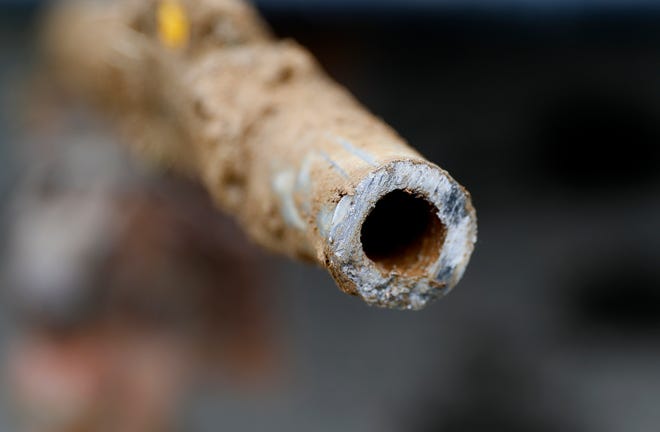Joe GuillenChristine MacDonaldJennifer Dixon
Detroit Free Press

(Note: Snyder hearing, above, begins at the 27:15 mark in the video)
The criminal investigation into the Flint water crisis burst open in historic fashion on Thursday as Attorney General Dana Nessel’s Office detailed sweeping new indictments against former Gov. Rick Snyder, members of his inner circle and others for their roles in the environmental catastrophe.
The charges include felony charges of obstruction of justice and extortion against Snyder’s former top aide, Richard Baird, and nine counts of involuntary manslaughter each against two former state health officials.
In all, nine people — most of them former government officials — were charged with a total of 42 counts as part of the criminal investigation into the 2014 disastrous switch by a cash-strapped Flint to use its river as its new water supply, which resulted in widespread lead contamination. They were arraigned Thursday morning and have been released after entering not guilty pleas and posting bond, according to court proceedings and the Genesee County Sheriff’s Office.
Snyder appeared in a Flint court Thursday morning and pleaded not guilty to two charges of willful neglect of duty, a misdemeanor.
Despite the lower-level charges compared with other defendants, the case against Snyder marked a significant moment in the state's political history. Snyder is the first Michigan governor or former governor to be charged for alleged criminal conduct while in office.

Supporters of the former Republican governor and his aides decried the prosecution as a reckless overreach fueled by partisanship.
But Snyder's critics say it was he who should have acted sooner when he knew or should have known there was something terribly wrong with the water Flint residents were drinking. Further, it was he who pushed for Michigan's emergency manager law and appointed the Flint overseers who managed the switch of the city's water supply to the Flint River. And it is Snyder, they say, who has given ambiguous and sometimes conflicting accounts about what he knew and when he knew it.
On Thursday, Nessel praised the high-wire prosecutions into the contamination of Flint's drinking water supply led by her Office's Solicitor General Fadwa Hammoud, as well as Wayne County Prosecutor Kym Worthy. Nessel had said earlier that she had walled herself off from the criminal cases, turning her focus instead to ongoing civil cases related to the contamination of Flint's drinking water beginning more than six years ago.
“Solicitor General Hammoud and Prosecutor Worthy’s track records demonstrate their commitment to public service as experienced prosecutors, which is why I appointed them to lead the criminal investigation in the Flint water crisis,” Nessel said in a statement Thursday around noontime. “I trust today’s announcement reflects their professional responsibilities and ethical obligations as the prosecuting authorities in this matter, and that their decisions are based solely on the facts, the law and the evidence.”
The evidence was reviewed by Genesee County Circuit Court Judge David Newblatt, who was appointed as a one-man grand juror to investigate crimes related to the crisis. The indictments followed a year's worth of grand jury proceedings.
The totality of the Flint water catastrophe may never be known, but the failures of public officials who "evaded accountability for far too long" continue to reverberate throughout the community, Hammoud said.
“When an entire city is victimized by the negligence and indifference of those in power, it deserves an uncompromising investigation that holds to account anyone who is criminally culpable. That is what all citizens in this state are entitled to regardless of their ZIP code," Hammoud said at a news conference Thursday.
"Let me be clear, there are no velvet ropes in our criminal justice system. Nobody, no matter how powerful or well-connected is above accountability when they commit a crime," she said.
Years ago, the office of the state's previous attorney general, Bill Schuette, pursued criminal charges against a number of the same defendants charged this week. But in June 2019, Nessel, the newly elected Democrat, upended that effort when her office dismissing all pending criminal charges, saying the initial Flint investigation had been bungled and opting instead to launch a new and expanded probe.
Her actions this week led to charges for the first time against Snyder.
In a remote court appearance Thursday morning whose social distance was necessitated by the novel coronavirus pandemic, Snyder, 62, wore a navy blazer, a light blue collared shirt without a necktie and a gray face mask. He was seated next to his attorney, Brian Lennon, in a Genesee County jail booth as they appeared for the hearing via Zoom. In a separate courtroom, connected by a computer link, a judge presided.
Snyder spoke sparingly during the hearing. His only words were “yes, your honor” in response to the judge’s question of whether he lives in the state. Snyder did not say which city or town.
During Snyder’s arraignment before Genesee District Judge Christopher Odette, Nessel's office sought to restrict Snyder's travel during the case by surrendering his passport because Snyder is a "man of means" with international contacts.

But Odette only ordered Snyder not to leave the state without the court's permission.
"I'm not going to have him surrender his passport on a misdemeanor charge," Odette said.
Odette also set a personal recognizance bond of $10,000 on each charge for Snyder. The former governor walked out of the county sheriff's office after the remote hearing but did not comment to awaiting reporters and photographers.
“The two misdemeanor charges filed today against former Gov. Rick Snyder are wholly without merit and this entire situation is puzzling,” Lennon, Snyder's attorney and partner at Warner Norcross + Judd, said in a statement after the hearing Thursday.
Nessel filed charges against Snyder and at least one other defendant quietly on Wednesday before holding a news conference with her lead prosecutors on Thursday morning.
Genesee County District Court records show the charges against Snyder stem from an alleged offense on April 25, 2014 — the day Flint began using the Flint River as its new water source.
Bacteria in the contaminated water was also blamed for an outbreak of Legionnaires’ disease. Authorities counted at least 90 cases in Genesee County, including 12 deaths. Legionnaires' disease is a severe form of pneumonia and often caught by inhaling the related bacteria from water.
The outbreak was announced by Snyder and his health department director in January 2016, even though some inside the administration later said they knew that cases had been discovered much earlier.
Each charge Snyder faces is a misdemeanor punishable by up to a year in prison or a fine of up to $1,000.
Prosecutors have rarely moved against the state's chief executives in or out of office. In 1975, former Democratic Gov. John Swainson was indicted for bribery while a member of the Michigan Supreme Court. Swainson, who was Michigan governor in 1961 and 1962, was later acquitted of the bribery charge but convicted of perjury. He died in 1994.
New charges in the Flint criminal case mark a dramatic escalation of the prosecution alleging criminal negligence. Some legal and public policy experts said the charges against Snyder were appropriate while expressing concern that the indictments could have some unintended consequences.
Paul Mohai, a professor at the University of Michigan’s School for Environment and Sustainability, said the charges against Snyder and the other officials are a step in the right direction toward environmental justice for the people of Flint. The city’s switch to the Flint River as its source of drinking water had disastrous consequences and “people should be held accountable for that,” Mohai said

Compounding the anger of the people of Flint, according to Mohai, were the state officials who chose to deny the problem and dismiss the evidence coming from the majority-Black city for more than a year.
Sara Hughes, an assistant professor at the University of Michigan’s School for Environment and Sustainability who studies urban policy, said that there is concern that the indictments could result in tightened governmental immunity protections and prompt public officials to “circle the wagons.”
“That would be a terrible outcome from this,” Hughes said. Instead, she hopes the case leads to politicians being held to a “higher standard” based on the public’s values.
Snyder, a Republican who has been out of office for two years, was governor when state-appointed managers in Flint switched the city’s water to the Flint River in 2014 as a cost-saving step while a pipeline was being built to Lake Huron. The water, however, was not treated to reduce corrosion — a disastrous decision affirmed by state regulators that caused lead to leach from old pipes and poison the distribution system used by nearly 100,000 residents.
Residents complained about discolored and foul-smelling water for over a year before the state acknowledged the problem. Flint switched back to Detroit water in October 2015, but the risk remained because of damage to the city's water infrastructure.

The prosecution also widened Thursday to include more serious charges against two of Snyder's former top aides as well as his former health department director.
Baird, a top aide to Snyder, has now been charged with four felonies, including extortion and obstruction of justice. He pleaded not guilty before Genesee Circuit Judge Elizabeth Kelly on Thursday

According to his indictment, Baird, 64, was charged with perjury for making a false statement during an interview with the attorney general’s office on March 1, 2017. The obstruction of justice charge stems from an alleged attempt to influence or interfere with the water crisis legal proceedings. Baird’s extortion charge is related to an alleged threat to a leader of the state-appointed Flint Area Community Health and Environmental Partnership during the organization’s investigation into the source of the Legionnaires’ disease outbreak associated with the contaminated water.
Baird’s attorney Randall Levine said in a statement after the arraignment that the accusations are baseless and politically motivated.
“Mr. Baird is innocent of any wrongdoing and is being unfairly prosecuted by the state’s Democratic attorney general,” Levine said.
Kelly ordered Baird to surrender his passport, although he is allowed to travel for work between Michigan and Illinois, where he lives in Chicago. Baird is a member of the board of regents at Eastern Michigan University, according to Levine.
“The people of Flint are justifiably upset and angry about what happened in Flint,” Levine said. “Their government failed them at so many levels. However, the evidence will show that Rich Baird is not responsible for what occurred to the folks in the town where he grew up. I expect that he will be vindicated.”
Another member of Snyder's inner circle, Jarrod Agen, the governor's former communications director and chief of staff, was also among the newly charged, with one count of perjury during an investigative subpoena examination, a felony punishable by up to 15 years in prison.
Through his attorney, Agen, 43, entered a plea of not guilty.
After working for Snyder, Agen became Vice President Mike Pence’s communications director and is now a spokesman for Lockheed Martin, a defense contractor. Agen’s attorney J. Benjamin Dolan did not immediately return a call for comment.
Former health department director Nick Lyon, 52, was also charged again Thursday morning with nine counts of involuntary manslaughter, a felony punishable by up to 15 years in prison. He also faces a misdemeanor charge of willful neglect of duty. He pleaded not guilty to all charges.
The manslaughter charges Lyon faces, according to his indictment, are for causing the deaths of nine people through the “grossly negligent failure” to protect the health of Michigan citizens

The judge set a $200,000 cash surety bond for Lyon on all the charges. His lawyer Charles Chamberlain said his client is innocent and called it a “dangerous day for state employees”
“Our hearts go out to Flint citizens who have endured the fallout from that decision,” Chamberlain said in a written statement. “But it does not help the people of Flint — or our criminal justice system — for the State to charge innocent people with crimes.”
“He did not make the decision to switch the water supply and had nothing to do with handling the water. Everything he did as director of the Michigan Department of Health & Human Services (MDHHS) he did based on the advice of highly trained epidemiologists and public health scientists and experts who themselves were looking at the science and following the data. It’s apparent that once again, the Attorney General has ignored the facts and the evidence.”
Also charged with nine felony counts of involuntary manslaughter was Dr. Eden Wells, 58, the state's former chief medical executive. She was also charged with two felony counts of misconduct in office and a misdemeanor charge of willful neglect of duty. The potential penalty for each charge is: up to 15 years in prison on the involuntary manslaughter charges, up to five years in prison on the misconduct in office charges and up to one year in prison on the misdemeanor
During her court hearing Thursday in Flint, she asked the court to enter a not guilty plea. The judge allowed her to continue to live in Maine while she faces the charges.
There were others accused of related crimes, too: former Flint Department of Public Works Director Howard Croft; two former Flint emergency managers, Darnell Earley and Gerald Ambrose, and Nancy Peeler, a manager in the Michigan Department of Health and Human Services’ early childhood health section.

Several of those charged Thursday had also been charged in the state’s first effort to prosecute those responsible.
Lyon was charged previously with one count of involuntary manslaughter. Wells was charged with obstruction of justice and lying to a police officer. Earley was charged with false pretenses and conspiracy, both 20-year felonies, and other charges. Ambrose was charged with false pretenses, conspiracy, misconduct in office and willful neglect of duty. Croft was charged with conspiracy and false pretenses.
The latest charges revealed on Thursday have been expected for days, but Nessel's Office refused to provide any information about the charges until Thursday. Wayne County Prosecutor Worthy said the state's grand jury laws require such secrecy.
Worthy said any suggestion that the attorney general's office withheld information is disingenuous.
"Had we disclosed this information from the grand jury in violation of these secrecy provisions that I’ve outlined, it would not only perhaps jeopardized our investigation but it would’ve been a crime," Worthy said.
It is unclear how much the years-long investigation has cost so far.
"We never put a dollar value on this investigation," Hammoud said.

Some community and religious leaders welcomed the news about the revived prosecutions in the Flint water case, especially charges brought against the former governor.
"Snyder did not protect and serve the people. He did not look out for our well-being, and for that he should be held accountable," Bishop Bernadel Jefferson of the Faith Deliverance Center in Flint said in a statement.
Eileen Hayes, executive director of Michigan Faith in Action, called Nessel's expanded prosecutions "a step in the right direction."
"It felt as though the governor was getting off scot-free and that other players who were also bad actors were getting away with it too. The idea that now, something is going to happen — there is some solace in that," Hayes said in a statement.
Flint Mayor Sheldon Neeley said in a statement that the new charges confirm there were multiple levels of wrongdoing to the community.
“The Flint community has waited nearly seven years for these steps toward justice,” Neeley said.
Summary of defendants and charges:
All nine defendants arraigned Thursday morning have been released after posting bond, according to the Genesee County Sheriff’s Office.
Jarrod Agen – former Director of Communications and former Chief of Staff, Executive Office of Gov. Rick Snyder; one count of perjury – a 15-year felony
Gerald Ambrose – former City of Flint Emergency Manager; four counts of misconduct in office – each a five-year felony and/or $10,000 fine
Richard Baird – former Transformation Manager and Senior Adviser, Executive Office of Gov. Snyder; one count of perjury – a 15-year felony; one count of official misconduct in office – a five-year felony and/or $10,000 fine; one count of obstruction of justice – a five-year felony and/or $10,000 fine; and one count of extortion – a 20-year felony and/or $10,000 fine
Howard Croft – former Director of the City of Flint Department of Public Works; two counts of willful neglect of duty – each a one-year misdemeanor and/or $1,000 fine
Darnell Earley – former City of Flint Emergency Manager; three counts of misconduct in office – each a five-year felony and/or $10,000 fine
Nicolas Lyon – former Director, Michigan Department of Health and Human Services; nine counts of involuntary manslaughter – each a 15-year felony and/or $7,500 fine; and one count of willful neglect of duty – a one-year misdemeanor and/or $1,000 fine
Nancy Peeler – Early Childhood Health Section Manager, Michigan Department of Health and Human Services; two counts of misconduct in office – each a five-year felony and/or $10,000 fine; and one count of willful neglect of duty – a one-year misdemeanor and/or $1,000 fine
Richard Snyder – former Governor of Michigan; two counts of willful neglect of duty – each a one-year misdemeanor and/or $1,000 fine
Eden Wells – former Chief Medical Executive, Michigan Department of Health and Human Services; nine counts of involuntary manslaughter – each a 15-year felony and/or $7,500 fine; two counts of misconduct in office – each a five-year felony and/or $10,000 fine; and one count of willful neglect of duty – a one-year misdemeanor and/or $1,000 fine
Staff writer Paul Egan contributed to this







